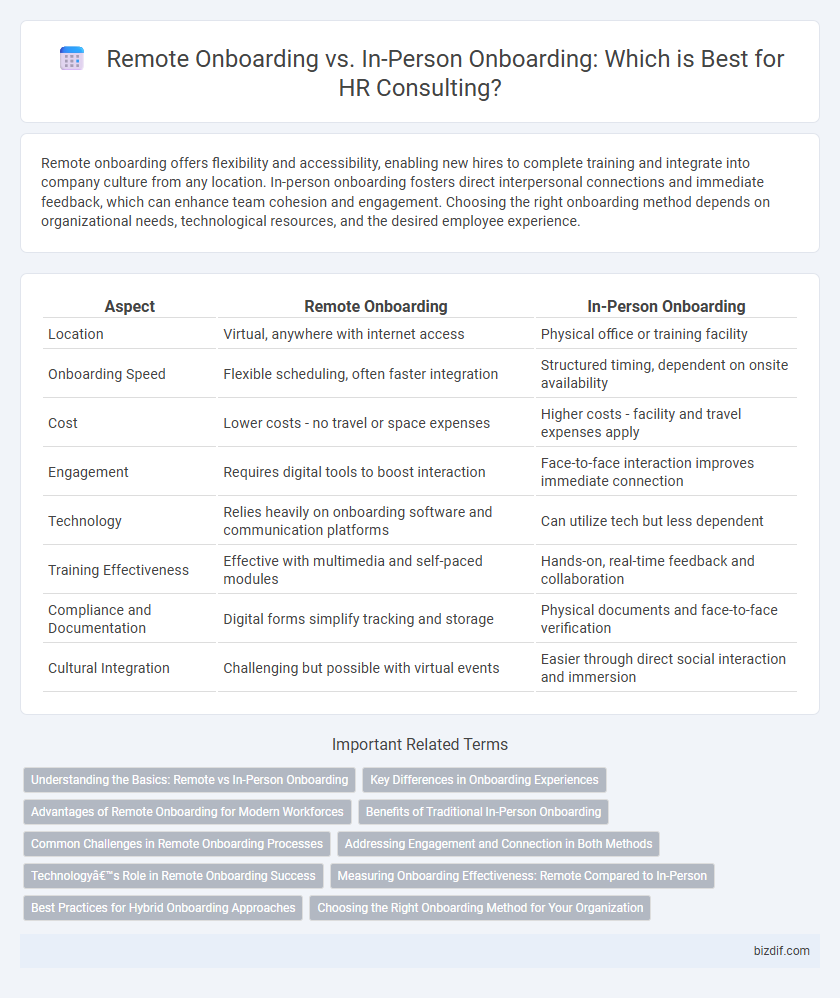Remote onboarding offers flexibility and accessibility, enabling new hires to complete training and integrate into company culture from any location. In-person onboarding fosters direct interpersonal connections and immediate feedback, which can enhance team cohesion and engagement. Choosing the right onboarding method depends on organizational needs, technological resources, and the desired employee experience.
Table of Comparison
| Aspect | Remote Onboarding | In-Person Onboarding |
|---|---|---|
| Location | Virtual, anywhere with internet access | Physical office or training facility |
| Onboarding Speed | Flexible scheduling, often faster integration | Structured timing, dependent on onsite availability |
| Cost | Lower costs - no travel or space expenses | Higher costs - facility and travel expenses apply |
| Engagement | Requires digital tools to boost interaction | Face-to-face interaction improves immediate connection |
| Technology | Relies heavily on onboarding software and communication platforms | Can utilize tech but less dependent |
| Training Effectiveness | Effective with multimedia and self-paced modules | Hands-on, real-time feedback and collaboration |
| Compliance and Documentation | Digital forms simplify tracking and storage | Physical documents and face-to-face verification |
| Cultural Integration | Challenging but possible with virtual events | Easier through direct social interaction and immersion |
Understanding the Basics: Remote vs In-Person Onboarding
Remote onboarding leverages digital tools such as video conferencing, cloud-based training modules, and virtual collaboration platforms to integrate new hires efficiently from any location. In-person onboarding emphasizes face-to-face interactions, hands-on training, and immediate access to workplace resources, fostering stronger interpersonal connections and cultural immersion. Understanding these fundamental differences helps HR professionals tailor onboarding strategies to enhance employee engagement and productivity.
Key Differences in Onboarding Experiences
Remote onboarding leverages digital platforms to deliver training and integrate new hires, emphasizing flexibility and accessibility, while in-person onboarding offers direct interaction, immediate feedback, and hands-on experience. Remote processes rely heavily on virtual communication tools and online resources, enabling global talent integration but potentially lacking in personal connection. In contrast, in-person onboarding fosters team bonding and cultural immersion through face-to-face engagement, which can accelerate relationship-building and employee acclimation.
Advantages of Remote Onboarding for Modern Workforces
Remote onboarding offers unparalleled flexibility, allowing new hires to seamlessly integrate into company culture regardless of location, which enhances employee satisfaction and retention rates in a dispersed workforce. Digital onboarding platforms provide instant access to resources, training modules, and communication tools that streamline the assimilation process and boost productivity from day one. Cost savings on physical space and travel expenses make remote onboarding a scalable and efficient solution for modern organizations expanding their talent pools globally.
Benefits of Traditional In-Person Onboarding
Traditional in-person onboarding fosters stronger employee engagement through face-to-face interactions and immediate feedback, enhancing team cohesion and cultural assimilation. Physical presence allows new hires to build personal relationships with colleagues and managers, which improves communication and collaboration. Additionally, in-person onboarding provides direct access to resources and hands-on training, accelerating skill acquisition and reducing onboarding time.
Common Challenges in Remote Onboarding Processes
Remote onboarding often faces challenges like limited personal interaction, which can hinder relationship building and team integration for new hires. Technical difficulties with software access and connectivity can delay training and productivity, increasing the risk of early disengagement. Ensuring consistent communication and providing comprehensive resources are critical to overcoming these obstacles and improving remote employee retention.
Addressing Engagement and Connection in Both Methods
Remote onboarding leverages digital tools like video conferencing and collaboration platforms to foster engagement and connection, ensuring new hires feel integrated despite physical distance. In-person onboarding emphasizes face-to-face interactions and immersive experiences that build immediate rapport and cultural understanding. Combining clear communication strategies and personalized touchpoints enhances employee engagement and connection in both remote and in-person onboarding processes.
Technology’s Role in Remote Onboarding Success
Technology plays a pivotal role in remote onboarding success by enabling seamless communication, digital document management, and real-time training through platforms like Zoom, Microsoft Teams, and onboarding-specific software such as BambooHR. Virtual onboarding tools foster employee engagement and collaboration, reducing the sense of isolation and accelerating productivity despite physical distance. Automated workflows and AI-driven analytics provide HR teams with actionable insights and streamline compliance, ensuring a smooth onboarding experience that rivals traditional in-person methods.
Measuring Onboarding Effectiveness: Remote Compared to In-Person
Measuring onboarding effectiveness requires analyzing key performance indicators such as employee retention rates, time-to-productivity, and new hire engagement scores for both remote and in-person onboarding processes. Remote onboarding often leverages digital tools to track real-time progress and gather feedback, while in-person onboarding benefits from direct observation and immediate interaction. Data from HR analytics platforms reveals that combining quantitative metrics with qualitative insights enhances the evaluation of onboarding success across both modalities.
Best Practices for Hybrid Onboarding Approaches
Effective hybrid onboarding integrates structured virtual training sessions with scheduled in-person meet-and-greet opportunities to build strong employee connections and ensure comprehensive learning. Leveraging digital collaboration tools alongside periodic on-site check-ins enhances engagement and fosters a cohesive company culture. Prioritizing clear communication, personalized support, and consistent feedback mechanisms optimizes the hybrid onboarding experience for remote and in-office employees alike.
Choosing the Right Onboarding Method for Your Organization
Choosing the right onboarding method depends on your organization's structure, culture, and employee needs. Remote onboarding offers flexibility and scalability, ideal for distributed teams, while in-person onboarding fosters direct interaction and stronger team bonding essential for collaborative company cultures. Evaluating factors like technology infrastructure, job roles, and employee engagement can help tailor the onboarding process to maximize productivity and retention.
Remote Onboarding vs In-Person Onboarding Infographic

 bizdif.com
bizdif.com